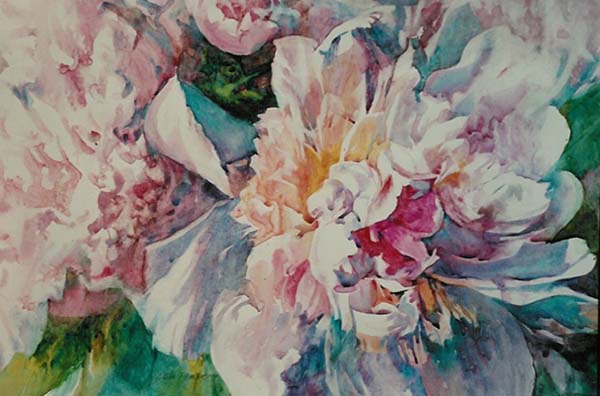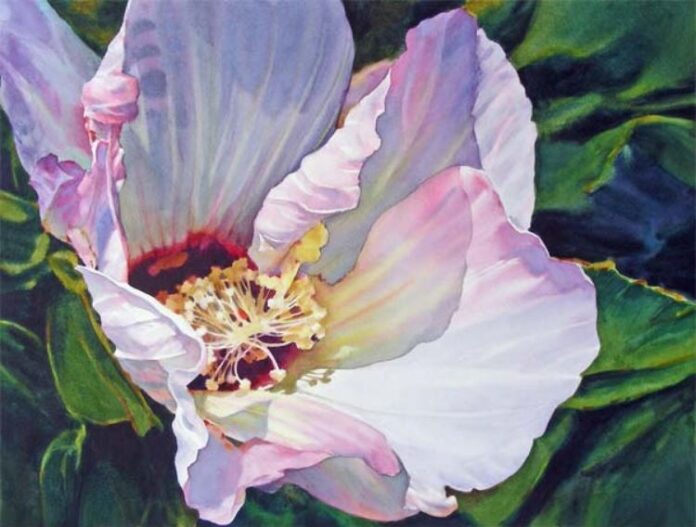Ann Pember makes painting a petal look effortless and yet far from simple with wet-in-wet watercolor washes. Here, she walks us through her thought process and the decisions she makes before she even picks up the brush.
Painting Petals: Plan First
by Ann Pember
My watercolor painting process has evolved over about 50 years. It is certainly not effortless. Years of practice, drawing, art major classes at a 4-year art college, practicing art commercially for 12 years, and taking workshops in watercolor with artists whose work I admired, all helped me learn what might work best for me.
Practice alone can bring a certain amount of confidence and helps shape one’s style of working. I started drawing as a child when I was able to hold a pencil. I was introduced to watercolor in high school and in college found it calling to me more than the other mediums I tried.
Early on, my work was tight, colors were rather pale and lacked depth. I realized that the light is what created the effects I hoped to achieve as I painted various subjects. As I practiced and studied, I began to see the importance of value change, edge quality, clarity of transparent pigment, paper, brush type, and so much more. Mixing colors using the primaries provided the most beautiful results for me, so I rarely use tube mixed color, gray, or black, but mix them instead.

My method is a simple one. There is a great deal of thinking and prep before painting. As much as possible needs to be figured out before I begin. I have a mental picture of the finished result and as many decisions made as possible, with a simple composition and drawing worked out and an idea, sketch, or value study of the light pattern. Then I wet my paints and brushes and paint quickly.
If I lose concentration, or question what to do, I stop until I can “see it” as I desire. Yes, sometimes changes happen as I paint and that can be a blessing or a challenge. The creative and analytical parts of the mind are taking turns throughout the process. It becomes almost a meditation when things go well.
Every part of the process helps me learn about the subject and how I will express it on paper. That connection with the subject begins with taking my own photos, or sketches. I need an emotional connection to it to give it that “something more” than a photo.

I do work from photos I’ve taken and only do so if the lighting is exciting. I do lots of editing with the camera first; often getting in close to the subject to simplify the design. There is more editing as I develop a drawing. I now use Photoshop first, moving or eliminating elements to improve the design. I might also work from more than one photo. Once I’m happy with a design, I enlarge the drawing, using a grid system to transfer it to the paper, keeping the lines light and simple. I work out values and color palettes in a sketchbook and usually keep to a limited palette of transparent colors. Color does vary from one paint company to another and I rely on my favorites; Winsor Newton, Daniel Smith, Maimeri, and Mission Gold. I keep a generous amount of paint in a Robert E. Wood palette, filling the wells.
I paint directly, mixing color wet in wet in sections on the surface of the paper, rather than glazing in many layers, which I gave up about 15 years ago. I wet a section, float in paint and let it mingle, charging in darks before the area dries. This helps me achieve clean, luminous color quickly and to the viewer, perhaps effortlessly. Edges are softened as needed in the process. I use papers and boards that allow lifting and support this style of painting; Waterford, Fabriano, Lanaquarelle, Illustration board, and watercolor board, as well as Yupo and coated surfaces.
- Connect with Ann Pember
- Art Workshop 1: Painting in the Flow of Watercolor on High Plate Illustration Board
- Art Workshop 2: Vibrant Orchid
- Visit PaintTube.tv to learn how to paint portraits and figures in the style of contemporary realism, and much more.
- Join us for the next annual Realism Live virtual art conference and study with the world’s best realism artists.
- Become a Realism Today Ambassador for the chance to see your work featured in our newsletter, on our social media, and on this site.





